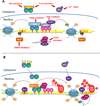Targeting HIV latency: pharmacologic strategies toward eradication
- PMID: 23270785
- PMCID: PMC3672351
- DOI: 10.1016/j.drudis.2012.12.008
Targeting HIV latency: pharmacologic strategies toward eradication
Abstract
The latent reservoir for HIV-1 in resting CD4(+) T cells remains a major barrier to HIV-1 eradication, even though highly active antiretroviral therapy (HAART) can successfully reduce plasma HIV-1 levels to below the detection limit of clinical assays and reverse disease progression. Proposed eradication strategies involve reactivation of this latent reservoir. Multiple mechanisms are believed to be involved in maintaining HIV-1 latency, mostly through suppression of transcription. These include cytoplasmic sequestration of host transcription factors and epigenetic modifications such as histone deacetylation, histone methylation and DNA methylation. Therefore, strategies targeting these mechanisms have been explored for reactivation of the latent reservoir. In this review, we discuss current pharmacological approaches toward eradication, focusing on small molecule latency-reversing agents, their mechanisms, advantages and limitations.
Copyright © 2012 Elsevier Ltd. All rights reserved.
Conflict of interest statement
The authors have no conflict of interest to declare.
Figures

References
-
- Blankson JN, et al. The challenge of viral reservoirs in HIV-1 infection. Annu. Rev. Med. 2002;53:557–593. - PubMed
-
- Chun TW, et al. Quantification of latent tissue reservoirs and total body viral load in HIV-1 infection. Nature. 1997;387:183–188. - PubMed
-
- Finzi D, et al. Identification of a reservoir for HIV-1 in patients on highly active antiretroviral therapy. Science. 1997;278:1295–1300. - PubMed
-
- Wong JK, et al. Recovery of replication competent HIV despite prolonged suppression of plasma viremia. Science. 1997;278:1291–1295. - PubMed
-
- Siliciano JD, et al. Long-term follow-up studies confirm the stability of the latent reservoir for HIV-1 in resting CD4 T cells. Nat. Med. 2003;9:727–728. - PubMed
Publication types
MeSH terms
Substances
Grants and funding
LinkOut - more resources
Full Text Sources
Other Literature Sources
Medical
Research Materials

